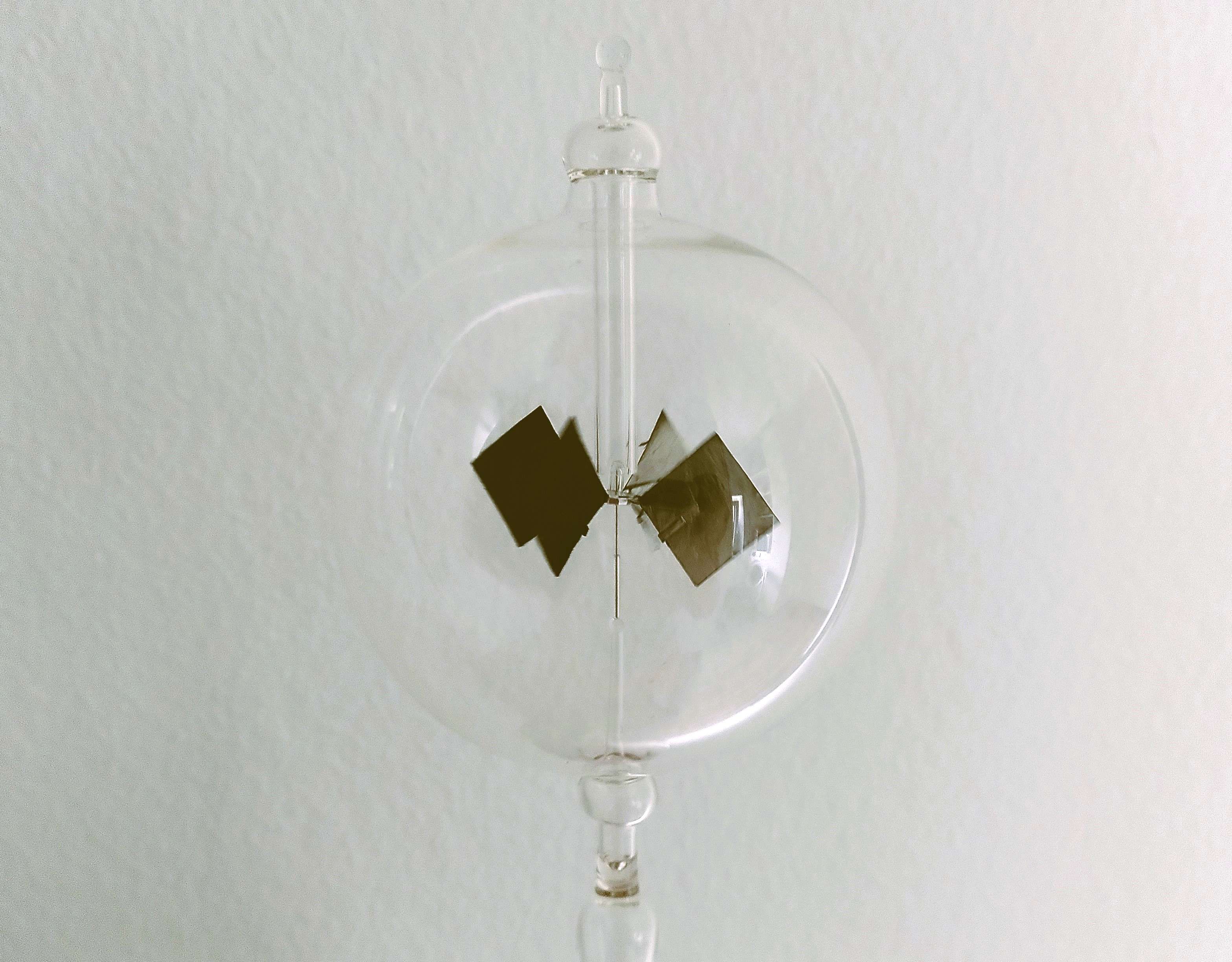13.3. Crookes’ radiometer#
Not colliding photons but … crawling gas molecules
| Author: | Kirsten Stadermann |
| Time: | 15-30 minutes |
| Age group: | from grade 11 |
Introduction#
A Crookes radiometer, or light mill, can be found in many physics cabinets. If you put it in front of the window it will start to spin, but what makes it do that? Turn this beautiful phenomenon into a research project showing how science works.
Equipment#
A light mill
Sunlight
Different light sources (laser pointer, torch, LED)
Hairdryer
Ice cubes
Black cloth

Fig. 13.7 A radiometer from Crookes#
Preparation#
Have all materials in reach.
Procedure#
Demonstrate that the mill turns as soon as it hits the sunlight.
In pairs, write what a reasoned explanation (= hypothesis) for this phenomenon is.
Collect all the ideas and then ask, again in pairs, to devise an experiment to test the hypothesis. For this, all the objects that are ready may be used. Other proposals are also fine, as long as the student can explain how it may answer the question.
To address students’ inquiry skills you can scaffold their investigation by:
Systematically applying PEOE at each step.
Clearly distinguishing between between observation and conclusion (or interpretation). A table with the headings “Experiment, Observation, Interpretation/Conclusion (= next testable hypothesis)” may makes things even clearer.
In case no one suggests it: predict what happens when you use ice cubes to cool the light mill.
If necessary, give as homework assignment to search for explanations on the internet. There are lots of different explanations available! We came across many explanations that don’t make sense. You can discuss: “How do ideas stay alive, how do they die, or don’t they die? How does this link to science and science communication? Moreover, did we check all possible explanations? Are we really sure now what causes the radiometer to spin?”
A question that can be asked to check students’ understanding: Why is the light mill inside the glass sphere with low air pressure? Wouldn’t it work much better with more air, because then more molecules collide with the fins?
Physics background#
Possible outcome of the investigation using the proposed table.
Experiment |
Observation |
Interpretation/conclusion |
|---|---|---|
Sunlight falls on the mill. |
Mill starts turning (shiny side at the front, black side of the blades at the back) |
It has something to do with light. |
LED lamp shines on the mill |
Mill does not turn. |
It is not light but heat that matters. |
Using the hair dryer to warm up the light mill |
Mill turns quickly |
It could indeed be heat. |
Warm up the light mill in the dark (for example with the hair dryer) |
Mill turns quickly |
Light doesn’t matter heat does. |
Cool down the light mill with ice cubes. |
Mill turn the other way round |
The colour (black or reflective) of the blades matters. |
Put the light mill completely in vacuum |
Because this is not possible at school, tell what comes out: the mill will then no longer turn, even in sunlight. |
Since the mill only turns when there is still a little gas at the blades, it could have to do with the movement of the gas molecules. |
A commonly found explanation is the following: The black-coloured side of the blade is warmer than the shiny side, so the gas molecules on the black-coloured side have a higher average speed. When these fast gas molecules collide with the dark side of the fins, the mill (on average) gets a bigger “kick” than the average “kick” of the shiny side, where the molecules move less fast, because it is less hot there. The recoil of these “kicks” pushes on the black side of the fins and is responsible for the observed rotation.
This, however, this is not the latest state of science: The currently accepted explanation was formulated by Osborne Reynolds in 1879 []. According to this explanation, an effect akin to thermal transpiration would be the cause of the movement: On average, gas molecules move from the hot side to the cold side. Due to the tangential force of the movement of the rarefied gas moving from the warmer to the colder side, you get a the pressure difference and the cold (reflective) side moves forward.
Tip
There is a Dutch National Exam Question that can be used when doing this demonstration. Have students write down or explain exactly what the difference is between the two effects for rotation by light. Discuss whether you could still rotate Crookes radiometer in the other direction under certain conditions.
The English-language explanation on Wikipedia (Crookes radiometer) shows the whole history of the different possible explanations.
